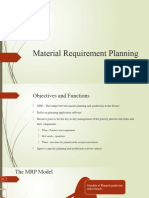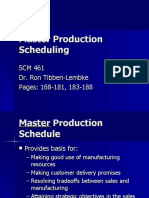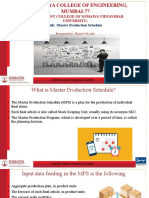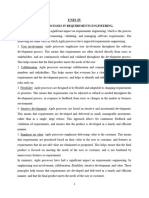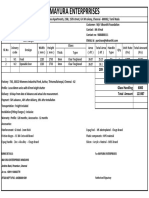Month
Working days
Forecast demand
Planned production
Planned ending inventory
MAY
21
115
168
153
Total required production
Production per working day
560
8
JUN
19
125
152
180
JUL
20
140
160
200
AUG
10
150
80
130
Total
70
530
�The Mesa Table Company has projected the following demand for its dining room table line. Produce a
next six months. There are currently 35 units on hand in inventory, and Mesa would like to have 15 un
Month 6. Compute the extra cost (above labor and materials) of your production plan if ending invento
month and backorders cost $30 per unit per month.
Month
Forecasted demand
Planned production
Ending inventory
1
740
2
720
3
860
4
900
5
810
6
700
�m table line. Produce a level production plan for the
would like to have 15 units on hand at the end of
n plan if ending inventory costs $10 per unit per
�Month
Forecasted demand
Planned production
Ending inventory
1
740
785
80
Total required production
Production per period
4710
785
Total inventory cost
Total backorder cost
Total additional cost
3100
3450
6550
2
720
785
145
3
860
785
70
4
900
785
-45
5
810
785
-70
�6
700
785
15
Total
4730
4710
�The MPS planner at Murphy Motors uses MPS time-phased records for planning end-item production. T
currently working on a schedule for the P24, one of Murphy's top-selling motors. The planner uses a p
of 70 units, a safety stock of 5 units, and a demand time fence of 1 week.
A. Complete the MPS time-phased record for product P24.
B. Can Murphy accept the following orders? Consider the orders in the sequence that they are listed.
Order
Amount
Week
1
40
4
2
30
6
3
40
2
4
28
3
Item: P24
Forecast
Booked Orders
Projected Available Balance
ATP
MPS
On-Hand
20
Week 1
30
13
Week 2
30
8
Week 3
35
4
Week 4
40
�g end-item production. The planner is
rs. The planner uses a production lot size
nce that they are listed.
Week 5
40
Week 6
40
Week 7
45
Week 8
45
�Item: P24
Forecast
Booked Orders
Projected Available Balance
ATP
MPS
Order
Order
Order
Order
1
2
3
4
On-Hand
20
Week 1
30
13
7
7
Week 2
30
8
47
58
70
Week 3
35
4
12
Week 4
40
42
70
70
can be accepted. That leaves us with ATP of 30 in Week 4.
can be accepted. That leaves us with ATP of 40 in Week 5.
can be accepted. That leaves us with ATP of 18 in Week 2.
must be rejected (or the due date altered) because we only have 18 ATP for Weeks 2 and 3.
�Week 5
40
Week 6
40
Week 7
45
Week 8
45
72
70
70
32
57
70
70
12
ATP for Weeks 2 and 3.
�The BOMs for products A and B are given at the right. Data from inventory records are
shown in the table below. The MPS calls for production of 85 units of Product A to be
started in Week 3 and 100 units in Week 6. The MPS for Product B calls for 180 units to be
started in Week 5. Complete the MRP records for the next 6 weeks for items C,D,E,F.
Part
Lot-sizing rule
Lead time
Schedule receipts
Beginning inventory
C
Min 220
3 weeks
280 (Wk 1)
25
D
L4L
2 weeks
None
0
E
Mult 300
3 weeks
300 (Wk 3)
150
F
Mult 200
2 weeks
None
600
Part C
Gross requirements
Scheduled receipts
Projected ending inventory
Net requirements
Planned order receipts
Planned order releases
Week 1
Week 2
Week 3
Week 4
Week 5
Part D
Gross requirements
Scheduled receipts
Projected ending inventory
Net requirements
Planned order receipts
Planned order releases
Week 1
Week 2
Week 3
Week 4
Week 5
Part E
Gross requirements
Scheduled receipts
Projected ending inventory
Net requirements
Planned order receipts
Planned order releases
Week 1
Week 2
Week 3
Week 4
Week 5
Part F
Gross requirements
Scheduled receipts
Projected ending inventory
Net requirements
Planned order receipts
Week 1
Week 2
Week 3
Week 4
Week 5
�Planned order releases
C(2)
D(1)
F(2)
D(1)
E(1)
F(1)
Week 6
Week 6
Week 6
Week 6
F(2)
E(1)
F(1)
E(2)
F(1)
E(1)
F(1)
��Part C
Gross requirements
Scheduled receipts
Projected ending inventory
Net requirements
Planned order receipts
Planned order releases
Week 1
0
280
305
0
0
0
Week 2
0
0
305
0
0
0
Week 3
170
0
135
0
0
220
Week 4
0
0
135
0
0
Week 5
0
0
135
0
0
Part D
Gross requirements
Scheduled receipts
Projected ending inventory
Net requirements
Planned order receipts
Planned order releases
Week 1
0
0
0
0
0
85
Week 2
0
0
0
0
0
0
Week 3
85
0
0
85
85
180
Week 4
0
0
0
0
0
100
Week 5
180
0
0
180
180
Part E
Gross requirements
Scheduled receipts
Projected ending inventory
Net requirements
Planned order receipts
Planned order releases
Week 1
85
0
65
0
0
0
Week 2
0
0
65
0
0
300
Week 3
180
300
185
0
0
0
Week 4
100
0
85
0
0
Week 5
360
0
25
275
300
Part F
Gross requirements
Scheduled receipts
Projected ending inventory
Net requirements
Planned order receipts
Planned order releases
Week 1
170
0
430
0
0
400
Week 2
300
0
130
0
0
200
Week 3
360
0
170
230
400
0
Week 4
200
0
170
30
200
0
Week 5
0
0
170
0
0
�Week 6
200
0
155
65
220
Week 6
100
0
0
100
100
Week 6
0
0
25
0
0
Week 6
0
0
170
0
0
�Time period (in weeks)
Standard hours of work produced
Measured capacity of work center
11
1050
95.45455 standard hours of work per week
�per week
�Hours of standard work produced
Scheduled hours
Actual hours worked
Utilization
Efficiency
85
80
75
0.9375
1.133333

